Transformation from/to IR#
In this section, we explain how to transform numerical data to IR.
Poles#
We consider a Green’s function genereated by poles:
where \(\nu\) is a fermionic or bosonic Matsubara frequency. The corresponding specral function \(A(\omega)\) is given by
The modified (regularized) spectral function reads
for the logistic kernel. We immediately obtain
The following code demostrates this transformation for bosons.
import sparse_ir
import numpy as np
%matplotlib inline
import matplotlib.pyplot as plt
plt.rcParams['font.size'] = 15
beta = 15
wmax = 10
basis_b = sparse_ir.FiniteTempBasis("B", beta, wmax, eps=1e-10)
coeff = np.array([1])
omega_p = np.array([0.1])
rhol_pole = np.einsum('lp,p->l', basis_b.v(omega_p), coeff/np.tanh(0.5*beta*omega_p))
gl_pole = - basis_b.s * rhol_pole
plt.semilogy(np.abs(rhol_pole), marker="o", label=r"$|\rho_l|$")
plt.semilogy(np.abs(gl_pole), marker="x", label=r"$|g_l|$")
plt.xlabel(r"$l$")
plt.ylim([1e-5, 1e+1])
plt.legend(frameon=False)
plt.show()
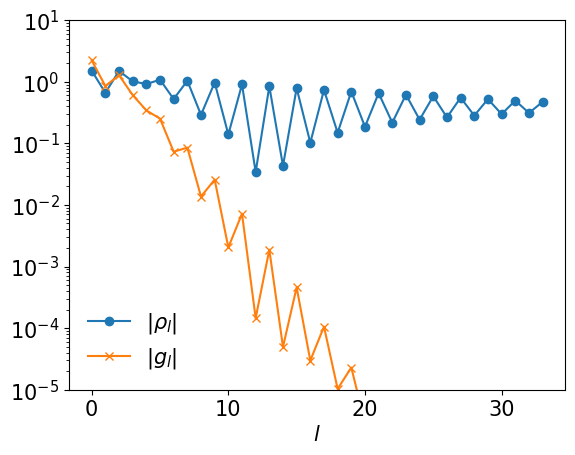
Alternatively, we can use DiscreteLehmannRepresentation
from sparse_ir.dlr import DiscreteLehmannRepresentation
dlr = DiscreteLehmannRepresentation(basis_b, omega_p)
gl_pole2 = dlr.to_IR(coeff/np.tanh(0.5*beta*omega_p))
plt.semilogy(np.abs(gl_pole2), marker="x", label=r"$|g_l|$ from DLR")
plt.semilogy(np.abs(gl_pole), marker="x", label=r"$|g_l|$")
plt.xlabel(r"$l$")
plt.ylim([1e-5, 1e+1])
plt.legend(frameon=False)
plt.show()
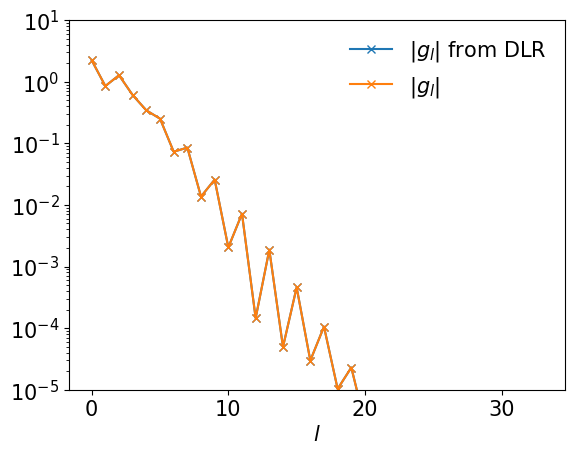
From smooth spectral function#
For a smooth spectral function \(\rho(\omega)\), the expansion coefficients can be evaluated by computing the integral
One might consider to use the Gauss-Legendre quadrature. As seen in previous sections, the distribution of \(V_l(\omega)\) is much denser than Legendre polynomial \(P_l(x(\tau))\) around \(\tau=0, \beta\). Thus, evaluating the integral precisely requires the use of composite Gauss–Legendre quadrature, where the whole inteval \([-\omega_\mathrm{max}, \omega_\mathrm{max}]\) is divided to subintervals and the normal Gauss-Legendre quadrature is applied to each interval. The roots of \(V_l(\omega)\) for the highest \(l\) used in the expansion is a reasonable choice of the division points. If \(\rho(\omega)\) is smooth enough within each subinterval, the result converges exponentially with increasing the degree of the Gauss-Legendre quadrature.
Below, we demonstrate how to compute \(\rho_l\) for a spectral function consisting of of three Gausssian peaks using the composite Gauss-Legendre quadrature. Then, \(\rho_l\) can be transformed to \(g_l\) by multiplying it with \(- S_l\).
# Three Gaussian peaks (normalized to 1)
gaussian = lambda x, mu, sigma:\
np.exp(-((x-mu)/sigma)**2)/(np.sqrt(np.pi)*sigma)
rho = lambda omega: 0.2*gaussian(omega, 0.0, 0.15) + \
0.4*gaussian(omega, 1.0, 0.8) + 0.4*gaussian(omega, -1.0, 0.8)
omegas = np.linspace(-5, 5, 1000)
plt.xlabel(r"$\omega$")
plt.ylabel(r"$\rho(\omega)$")
plt.plot(omegas, rho(omegas))
plt.show()
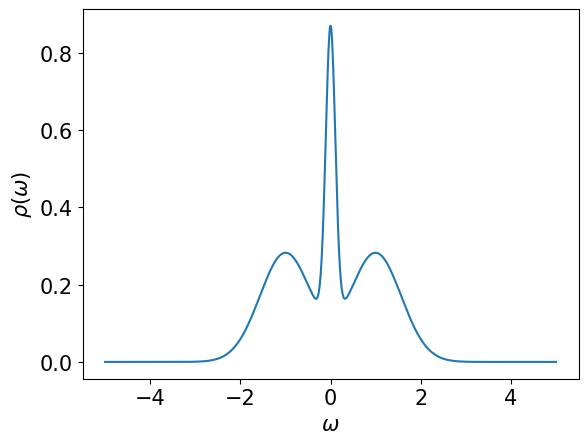
beta = 10
wmax = 10
basis = sparse_ir.FiniteTempBasis("F", beta, wmax, eps=1e-10)
rhol = basis.v.overlap(rho)
gl = - basis.s * rhol
plt.semilogy(np.abs(rhol), marker="o", ls="", label=r"$|\rho_l|$")
plt.semilogy(np.abs(gl), marker="s", ls="", label=r"$|g_l|$")
plt.semilogy(np.abs(basis.s), marker="", ls="--", label=r"$S_l$")
plt.xlabel(r"$l$")
plt.ylim([1e-5, 10])
plt.legend(frameon=False)
plt.show()
#plt.savefig("coeff.pdf")
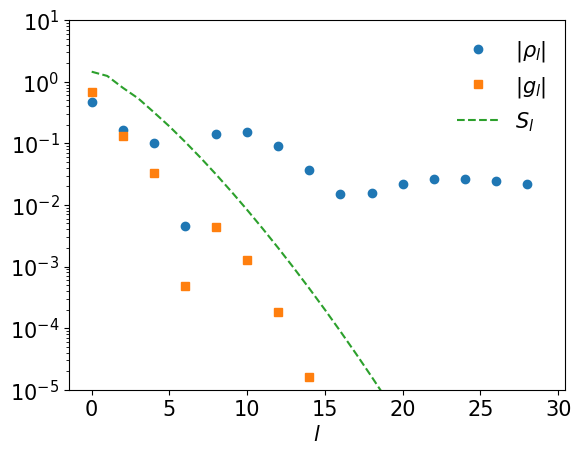
\(\rho_l\) is evaluated on arbitrary real frequencies as follows.
rho_omgea_reconst = basis.v(omegas).T @ rhol
plt.xlabel(r"$\omega$")
plt.ylabel(r"$\rho(\omega)$")
plt.plot(omegas, rho_omgea_reconst)
plt.show()
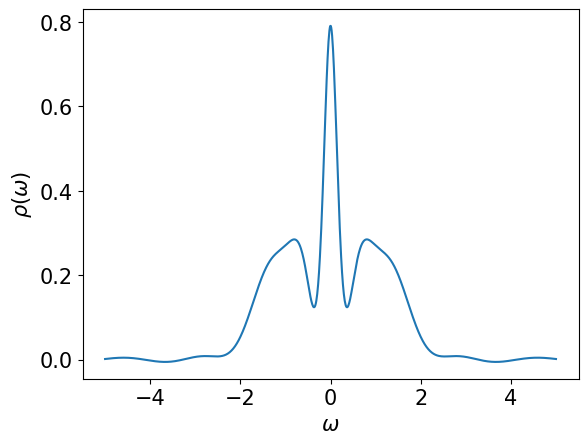
From IR to imaginary time#
We are now ready to evaluate \(g_l\) on arbitrary \(\tau\) points. A naive way is as follows.
taus = np.linspace(0, beta, 1000)
gtau1 = basis.u(taus).T @ gl
plt.plot(taus, gtau1)
plt.xlabel(r"$\tau$")
plt.ylabel(r"$G(\tau)$")
plt.show()
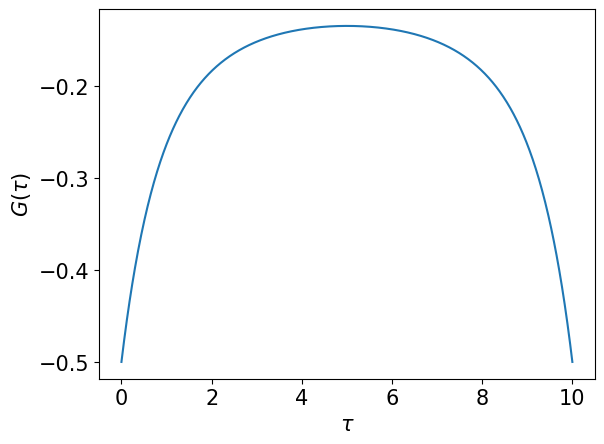
Alternatively, we can use TauSampling as follows.
smpl = sparse_ir.TauSampling(basis, taus)
gtau2 = smpl.evaluate(gl)
plt.plot(taus, gtau1)
plt.xlabel(r"$\tau$")
plt.ylabel(r"$G(\tau)$")
plt.show()

From full imaginary-time data#
A numerically stable way to expand \(G(\tau)\) in IR is evaluating the integral
You can use overlap function as well.
def eval_gtau(taus):
uval = basis.u(taus) #(nl, ntau)
if isinstance(taus, np.ndarray):
print(uval.shape, gl.shape)
return uval.T @ gl
else:
return uval.T @ gl
gl_reconst = basis.u.overlap(eval_gtau)
ls = np.arange(basis.size)
plt.semilogy(ls[::2], np.abs(gl_reconst)[::2], label="reconstructed", marker="+", ls="")
plt.semilogy(ls[::2], np.abs(gl)[::2], label="exact", marker="x", ls="")
plt.semilogy(ls[::2], np.abs(gl_reconst - gl)[::2], label="error", marker="p")
plt.xlabel(r"$l$")
plt.xlabel(r"$|g_l|$")
plt.ylim([1e-20, 1])
plt.legend(frameon=False)
plt.show()
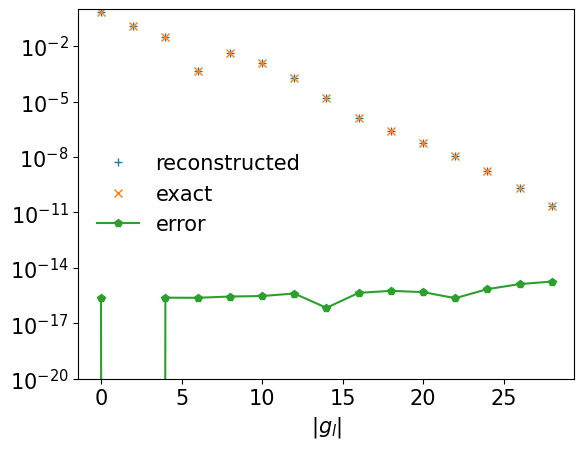
Remark: What happens if \(\omega_\mathrm{max}\) is too small?#
If \(G_l\) do not decay like \(S_l\), \(\omega_\mathrm{max}\) may be too small. Below, we numerically demonstrate it.
from scipy.integrate import quad
beta = 10
wmax = 0.5
basis_bad = sparse_ir.FiniteTempBasis("F", beta, wmax, eps=1e-10)
# We expand G(τ).
gl_bad = [quad(lambda x: eval_gtau(x) * basis_bad.u[l](x), 0, beta)[0] for l in range(basis_bad.size)]
plt.semilogy(np.abs(gl_bad), marker="s", ls="", label=r"$|g_l|$")
plt.semilogy(np.abs(basis_bad.s), marker="x", ls="--", label=r"$S_l$")
plt.xlabel(r"$l$")
plt.ylim([1e-5, 10])
#plt.xlim([0, basis.size])
plt.legend(frameon=False)
plt.show()
#plt.savefig("coeff_bad.pdf")
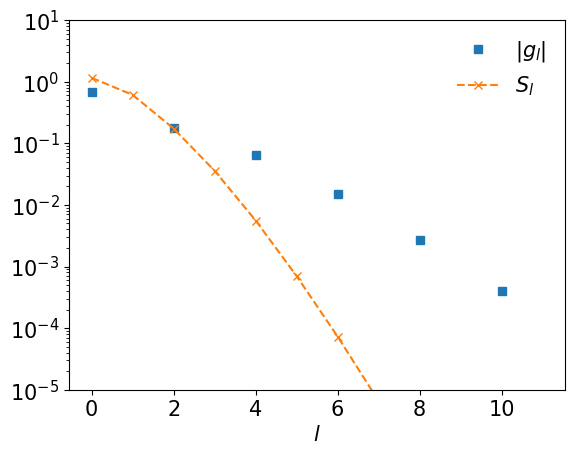
Matrix-valued object#
evaluate and fit accept a matrix-valued object as an input.
The axis to which the transformation applied can be specified by using the keyword augment axis.
np.random.seed(100)
shape = (1,2,3)
gl_tensor = np.random.randn(*shape)[..., np.newaxis] * gl[np.newaxis, :]
print("gl: ", gl.shape)
print("gl_tensor: ", gl_tensor.shape)
gl: (30,)
gl_tensor: (1, 2, 3, 30)
smpl_matsu = sparse_ir.MatsubaraSampling(basis)
gtau_tensor = smpl_matsu.evaluate(gl_tensor, axis=3)
print("gtau_tensor: ", gtau_tensor.shape)
gl_tensor_reconst = smpl_matsu.fit(gtau_tensor, axis=3)
assert np.allclose(gl_tensor, gl_tensor_reconst)
gtau_tensor: (1, 2, 3, 30)